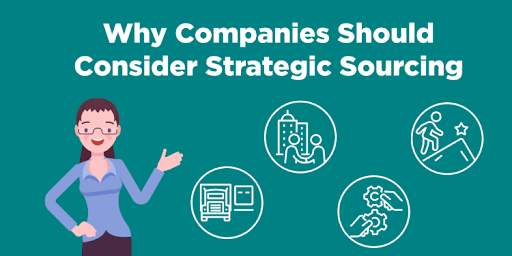What is Sourcing?
Finding the best supplier for your business that delivers good quality products with a price range suitable for the business’s profit margins is “Sourcing”. Its a hand in glove situation where sourcing is crucial for supply chain management, But before you can procure goods, it is essential to:
- Locate potential suppliers
- Establish a strict vetting procedure.
This mitigates chances of error during the sourcing process because going back might be costly. There are many businesses who exclusively prefer cost saving over strategic sourcing, but the prominent ones have started considering producing value while not disregarding waste reduction and cost in today’s competitive world.
As far as procurement is concerned, the sourcing team identifies, assesses and works with suppliers in order to achieve cost savings and best value for the products with necessary margin required that positively impact business.
To develop a competitive edge by locating a supplier at the lowest cost to obtain a distinctive value, the souring process is conducted through a tendering process and implemented at strategic levels.
The first phase in the supply chain process is usually the process of procuring goods in a company. Finding the correct balance between the raw material and product quality and price is significant component sourcing. The procurement team aims to reduce cost and boost sales and revenue. But how to analyze that you are using the best possible methods and strategies to make sourcing profitable?
In this article, we break down every step of the sourcing process, and explore types of sourcing in the supply chain management for a smarter procurement process and a smoother journey to sustainable growth. So, let’s get started.
Different Types of Sourcing
To successfully implement the sourcing in supply chain management you must have deep awareness of the entire business plan which includes the resources to deliver the goal, the market tactics as well as particular risks that hinder the process and the strategies to handle those.
The sole objective is not to obtain inexpensive goods and services; instead sourcing activities should prioritize creating such connections that benefit both parties. You directly connect wholesalers, manufacturers or sources from distributors depending on your sourcing needs and the product you want to purchase.
So, what sources of funding should you take into account?
1. Outsourcing
Outsourcing is about employing a third party outside of a corporation to carry out tasks or manufacture things that previously were done in-house. This can also be attained by moving operations overseas or collaborating with a local supplier. It is possible to outsource both front and back-office duties.
2. Insourcing
In this type of sourcing you assign tasks to a team or individual with your organization. This alternative is a great deal for business executives as it offers great cost savings and enables on-site evaluation of the essential items and services quality.
3. Near-sourcing
This type of sourcing involves placing your operation close to the location where your end-products are sold.
4. Low-cost Country Sourcing (LCCS)
Materials for LCCS are sourced from countries with cheap labor and production prices. This kind of sourcing aims to reduce an organization’s overall operational costs. For the majority of multinational firms, China has emerged as the preferred place for this kind of sourcing.
5. Global Sourcing
The world is changing with the rise in E-commerce activities and it has become a global village. Cross border purchase of products and services from the global market has become a simple and smoother task. This approach has numerous benefits and provides great exposure to your company to other markets while also giving the opportunity to explore how business is done throughout the world.
Additionally, you have access to a diverse variety of resources and talents that might not be largely accessible in your homeland.
6. Vertical Integration
This includes joining a business in the same industry that comprises various stages of production. Therefore, a company’s acquisition of its input supplier is considered as backward integration, whereas its acquisition of business in its supply chain is referred as a forward integration.
7. Few or many Suppliers
For commodity products, a multi supplier strategy is employed quite often, while the purchasing decisions are primarily made on price. While other suppliers might offer comparable products, single source purchasing refers to purchases made from one selected supplier.
The term “sole-source procurement” describes transactions with just one supplier.
8. Joint Ventures
This is a business created by two or more parties. Shared ownerships of returns and risk and governance are its key traits.
9. Virtual Enterprise
This type of sourcing occurs when separate businesses are connected through technology to share resources, cut expenses, and gain access to one another’s markets.
10. Captive Service Operations
This type of service provides an alternative for businesses looking for greater authority over their equipment sourcing and procurement services. This sort of sourcing provides greater confidence and control throughout the process because procurement is handled by a group firm or subsidiary.
This also covers the issues regarding the property, patents and retaining the significant privacy regarding the product debut and future plans.
This sourcing has obvious drawbacks as compared to other types such as cost inflation and a dearth of all-around knowledge.
Conclusion
In conclusion, identifying the complexities of sourcing in supply chain management requires a detailed analysis. While each type of sourcing offers advantages, the key lies in selecting the right strategy that aligns with your business goals.
Whether you’re optimizing for cost, quality, or operational control, it’s essential to prioritize long-term relationships and adaptability. Ignoring these factors can lead to missed opportunities and inefficiencies. The path to sustainable growth is not just about cutting costs—it’s about making informed decisions that drive value, reduce risks, and ensure a competitive edge in an ever-evolving market
If you want to read more interesting articles, check out the following ones:











